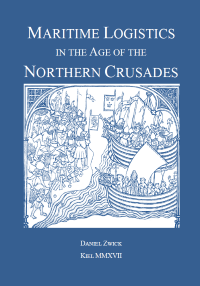
Zwick 2017: D. Zwick, Maritime Logistics in the Age of the Northern Crusades (Dissertation), University of Kiel.
List of contents
- Introduction
1.1. Principal aims of this study 3
1.2. Scope, limitations and some research history 3
1.2.1. ‘Maritime Logistics’ — A better way to contextualise shipwrecks? 3
1.2.2. The ‘Northern Crusades’ — An ahistorical construct or legitimate term? 5
1.3. Methodology 10 - The Baltic Sea as a maritime landscape
2.1. The physical landscape 11
2.2. The anthropogenic landscape 16
2.2.1. Fishing 16
2.2.2. Navigation 17
2.2.3. Seasonal logistics 22
2.2.4. Ship-finds as remnants of fossilised mobility? 25
2.3. Maritime transit zones and transshipment points 31
2.3.1. The Skagen route (Ummeland) 33
2.3.2. The Limfjord passage 36
2.3.3. The Schleswig – Hollingsted isthmus 37
2.3.4. Lübeck 38
2.3.5. Jutlandic interfaces: Assessing transitions in shipbuilding technology 42 - Organising maritime expeditions into uncharted waters: The communication networks of the Baltic Crusades (1198-1290)
3.1. A sea of myths: Medieval maritime cosmography 49
3.2. Itineraries as lineary networks 55
3.2.1. Written and graphic itineraries 56
3.2.2. Communication monopolies: Controlling geographical knowledge 57
3.3. King Valdemar’s Itinerary revisited 59
3.3.1. Rediscovery and research history 59
3.3.2. Two routes — one doctrine? 60
3.3.3. Initiator 62
3.3.4. A maritime equivalent to a marching route? 63
3.3.5. Successive genesis of a formalised route 66
3.3.6. Links to the leding-organisation 67
3.3.7. The significance of a detour 68
3.3.8. Toponyms as manifestations of real and imagined associations 68
3.4. The significance of the re-interpretation 72 - Ships in frontier zones of the north-eastern Baltic rim (13th century)
4.1. The Riga 3 ship and its port 74
4.1.1. Foundation and fortification 75
4.1.2. The Riga 3 wreck 80
4.1.3. Hybrid, intermediate form or variant in its own right? 82
4.2. The Matsalu ship-timbers 85
4.2.1. Date and provenance 86
4.2.2. Construction 86
4.2.3. Floor-timber dimensions as diagnostic feature? 89
4.3. Revisiting the Kuggmaren Ship in the Stockholm Archipelago 92
4.3.1. Date and provenance 93
4.3.2. Grain residues 95
4.3.2. Grain and horse transports along the Swedish coast: a hypothesis 96
4.4. The Egelskär Ship in the Finnish Archipelago 100
4.4.1. Date 100
4.4.2. The ship’s cargo and its origins 101
4.4.3. Contextualising ship and cargo: Cues on origin and destinations 102 - Woodland exploitation in the wake of the Prussian and Baltic crusades: Assessing maritime timber trade and its impact on shipbuilding (14th – 15th century)
5.1. Wood as managed resource 104
5.2. Baltic timber trade 105
5.2.1. Standardised timber products 107
5.2.2. Trade patterns emerge 108
5.2.3. Volume of trade 112
5.3. The case of the Beluga Ship: A Scandinavian wreck, built of Baltic timber and scrapped in a German city? 112
5.3.1. Discussing the preliminary results of the Beluga case study 113
5.3.2. Date and provenance 114
5.3.3. Construction 115
5.3.4. Interim results, statistical problems and new research questions 116
5.4. Extending the remit of the study 118
5.4.1. Is there a link between oak imports and shipbuildilding? 119
5.4.2. Cog-boards vs. wainscots 120
5.4.3. Choice or necessity? 121 - Wrecked in the Rubbles of the Livonian Confederation: Evaluating the transport geographical context of a shipwreck and a castle (16th century)
6.1. The Maasilinn Ship 124
6.1.1. Date, provenance and workmanship 125
6.1.2. Construction 125
6.1.3. The significance of the secondary carvel skin 132
6.1.4. Discussion 140
6.2. Exploring the castle’s link to the nearby Maasilinn wreck 141
6.3. Livonia Maritima in retrospect: Applying a Braudelian concept to a maritime transport zone 144 - General Conclusions
- Summary
- Zusammenfassung
- Bibliography
10.1. Primary literature, compiled and translated editions 158
10.2. Secondary literature 159 - Appendix
11.1. Transcription of King Valdemar’s Itinerary (Utlängan-Tallinn) 180
11.2. Naval warfare in the Chronicles of Henry of Livonia 182
11.3. Caulking material from the Kuggmaren wreck 186 - Curriculum Vitae
- Cumulative Papers
This is in part a cumulative and monograpic doctoral dissertation. The cumulative part is based on the following papers published by this author during the doctoral years. The facsimile or manuscript version of the respective papers are included in the appendix.





